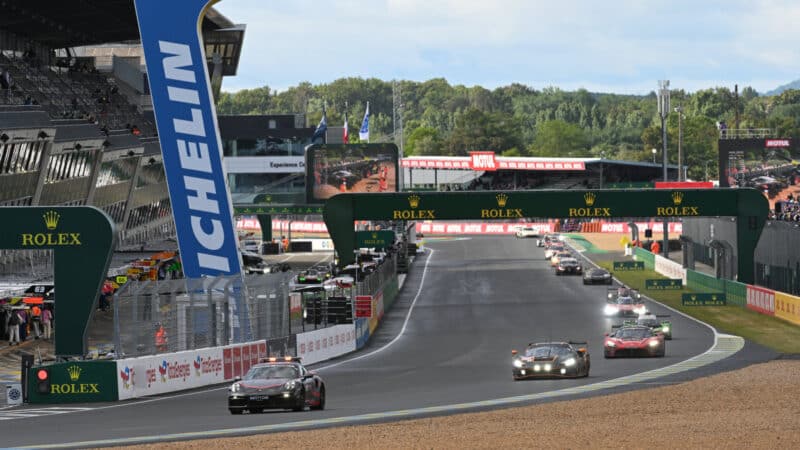Le Mans 24 Hours safety car procedure: a full guide
The Le Mans 24 Hours uses just a single safety car, after new procedures in 2023 resulted in chaos and confusion

The Le Mans safety car procedure was changed for 2024
Getty Images
The Le Mans 24 Hours uses a refined version of the safety car procedure introduced in 2023 which eliminates much of the category sorting that led to lengthy delays as well as confusion and frustration among drivers and race fans alike.
Previously, an incident which triggered more than a full course yellow (limiting each car’s speed) would be managed by three separate safety cars which would enter the circuit. Drivers would then have to remain behind the first safety car they encountered until a ‘merging’ period brought the entire field behind a single safety car, while the other two returned to the pitlane.
There would then be a ‘pass-around’ period, where any cars ahead of their class leader — in any category — could overtake the safety car and drive around the circuit until they reach the back of the queue. Finally there was then a ‘drop-back period’ when the field went through another reshuffle by category — Hypercars followed by LMP2s, ahead of GTs.
Although an improvement over the previous system, which would create artificial gaps between drivers in the same class, the safety car periods at the 2023 Le Mans 24 Hours still took upwards of 20 minutes and were heavily criticised.

A single safety car will lead the field at Le Mans
Getty Images
The 2025 system will continue to use three safety cars as opposed to just one, although the process was trimmed down last year in an effort to save time and get racing action back under way as soon as possible.
How new Le Mans safety car procedure works
In the hope of drastically reducing waiting times and getting racing back underway, the safety car procedure was simplified in 2024 and will continue to be used in 2025.
Deployment
When deemed necessary, the three safety cars will be deployed from their respective positions around the circuit: at Turns 10, 22 and 30. They will join the track regardless of where the race leader is and drivers must then line up behind the first safety car they encounter.
Merging
There will then be a merging period, in which two safety cars re-enter the pitlane and the entire field lines up behind just one.
Pass-Around
The race director will then authorise “Pass-Around” for any car that has their category leader behind them. They will be permitted to pass the safety car, drive around the circuit and rejoin the back of the queue. As per the FIA’s WEC Sporting regulations, it is the competitors’ responsibility to determine if their car is eligible for Pass-Around and notify the race director. The penalty for performing an ineligible Pass-Around is a hefty stop and go penalty equal in time to two racing laps.
Throughout the Pass-Around procedure, all cars passing the safety car must remain in line relative to each other and in the order that was initially established behind the safety car.
Racing resumes
After the circuit has been cleared all all hazards and all Pass-Arounds have been completed, the safety car will be brought back into the pitlane at the end of its current lap.
When this happens, just as in other racing series, the leader will then dictate the pace and should fall more than five lengths behind the safety car. As soon as the safety car has entered the pit-lane, racing can resume.
Exceptions
The procedures detailed above will not be applied within the last 60 minutes of the race. Instead, the race director will deploy just a single safety car which will aim to group the field together and get the race back underway as soon as possible.
If the safety car is required at the beginning of the final lap or is deployed during the final lap, the cars will take the chequered flag without any overtaking.
How long does the new safety car procedure take?
Due to cars no longer being required to be sorted by category during a ‘drop-back’ phase, the new safety car system should be much quicker than the old one.
After heavy rain impacted the start of last year’s Le Mans 24 Hours, forcing cars to be sent spinning into barriers, the safety car was deployed for an hour, with at least 20min spent on the restart procedure.
Why did the safety car procedure change in the first place?
The ACO stated that it dates back to the 2018 race, where an early safety car period effectively decided the result of the GTE Pro category. It was called just after the No92 Porsche pitted — a lap before its rivals.
This left the No92 car in the train behind one safety car which, by the time its rivals stopped, had passed the pit exit. They then had to wait to join the next safety car queue, to maintain an empty gap between the groups.
The No92 car gained a 2min cushion and maintained it to the end of the race.
Since then, the ACO has carried out “a long process of analysis and testing” to come up with the new format, and although this resulted in a fairer outcome, it arguably took too long to accomplish.
